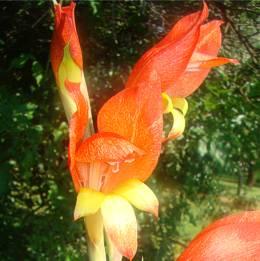Gladiolus dalenii
Gladiolus dalenii Van Geel
Family: Iridaceae
Common names: African gladiolus, parrot lily, sword lily (Eng.); papegaaigladiolus, wildeswaardlelie (Afr.); khahla-e-kholo (Sesotho); sidvwana (siSwati); isidwi esibomvu, uhlakahle, udwendweni (isiZulu)
Introduction
Gladiolus dalenii and other Gladiolus species are popular garden plants, cultivated in Europe for more than 250 years and renowned for their striking, colourful flowers. But did you know that these garden plants were grown from hybrids of wild gladioli native to South Africa?

Description
Description
Gladiolus dalenii is a deciduous evergreen perennial. It grows up to 2 m tall. Leaves erect, 20 mm wide, grey-green, in a loose fan. It produces five tall flower spikes with up to 7 large, intensely scarlet orange to red or variously coloured, hooded flowers with a bright yellow throat; bracts green to red-brown, clasping. Flowering in midsummer (December to February).

Conservation Status
Status
Over the past two centuries many South African irids such as gladioli, freesias, crocosmias, ixias and watsonias have been domesticated and are familiar garden plants. Some have been so improved by plant breeders that often it is not easy to associate modern garden hybrids with their humble wild ancestors in the veld.
In 1976, 1100 seeds collected in the wild were deposited at the Wakehurst Place Seed Bank (now the Millennium Seed Bank) in the United Kingdom, to determine whether cold storage of seed as a measure of long-term conservation was possible. This proved successful and tests carried out several years later at the seed bank showed a germination of 99% at 11ºC.
Gladiolus dalenii has been successfully cultivated at Kirstenbosch Botanic Garden for many years and is also being grown by several specialist bulb growers in several countries. Ideally its natural habitat should be formally protected, but, should this not be possible, ex situ material could possibly be used to re-establish this species elsewhere, in suitable sites.
Distribution and habitat
Distribution description
Gladiolus dalenii grows in the summer rainfall regions of the Eastern Cape north of East London to southern KwaZulu-Natal, from the coast to as far inland as the Lesotho border. Further north it extends through tropical Africa as far as western Arabia. It is found in open grassland, woodland and scrub and in rocky areas, often among rocks along streams, at altitudes up to 2500 m.
Derivation of name and historical aspects
History
The genus name Gladiolus is derived from the Latin gladius, meaning 'a small sword', and refers to the narrow, sword-shaped leaves produced by many Gladiolus species. This species wa named in 1828 after Cornelius Dalen, Director, Rotterdam Botanic Gardens, who introduced the species into gardens in Europe.

Ecology
Ecology
It is pollinated by sunbirds, which are attracted by the copious nectar produced by the flowers. The corms are eaten by bush pigs.
Uses
Use
It is used in traditional medicine to treat diarrhoea, chest ailments caused by sorcery, sterility in women, as good luck charms and in the horns of inyangas/sangomas. Cultivars developed in Europe in the early 1900s are grown worldwide and have become very successful cut-flowers.
The leaves are reported to be plaited to make ropes.

Growing Gladiolus dalenii
Grow
It is an easy plant to grow, and can be cultivated from corms as well as seeds. It should preferably be planted in light, well-drained, sandy loam soil in full sun. As this is a summer-growing species, plant corms in spring (around September) and give plenty of water all through the growing season. Corms are best planted in open ground, rather than pots, roughly 100 mm deep and 150 mm apart. One should avoid the use of inorganic fertilizers, especially those with high nitrogen content. Rather use compost, and bone meal can also be beneficial. The corms can be left in the soil during the winter dormancy period, or lifted and stored in a cool airy place to prevent decay.
References
- Manning, J., Goldblatt, P. & Snijman, D. 2002. The color encyclopedia of Cape bulbs. Timber Press, Oregon.
- Pooley, E. 1998. A field guide to wild flowers of KwaZulu-Natal and the Eastern Region. Natal Flora Publications Trust, Durban.
- Pooley, E. 2003. Mountain flowers, a field guide to the flora of the Drakensberg and Lesotho. Natal Flora Publications Trust, Durban.
Credits
Stemmer Ngalo
Free State NBG
April 2011
Plant Attributes:
Plant Type: Bulb, Perennial
SA Distribution: Eastern Cape, KwaZulu-Natal
Soil type: Loam
Flowering season: Late Summer
PH: Neutral
Flower colour: Red, Yellow, Orange
Aspect: Full Sun
Gardening skill: Easy
Special Features:
Horticultural zones










Rate this article
Article well written and informative
Rate this plant
Is this an interesting plant?
User Comments
Chris Jones, Portugal
June 24, 2020 at 8:01 PMHello,
I have a photo taken of what I think is Gladiolus dalenii Van Geel. It comes from the high Drakensberg near the Amphitheatre, and look very much like this flower. HOWEVER ... it was not "Flowering December to February". We were there in first 2 weeks of MAY. They were flowering then - so autumn/early winter flowering. I have sent you these 3 photos - (which strangely seem to have become 'landscape?') - hopefully these will be useful?
Another thing about this article is, 3 of the photos are on their sides! Maybe someone could make them upright?
Login to add your Comment
Back to topNot registered yet? Click here to register.